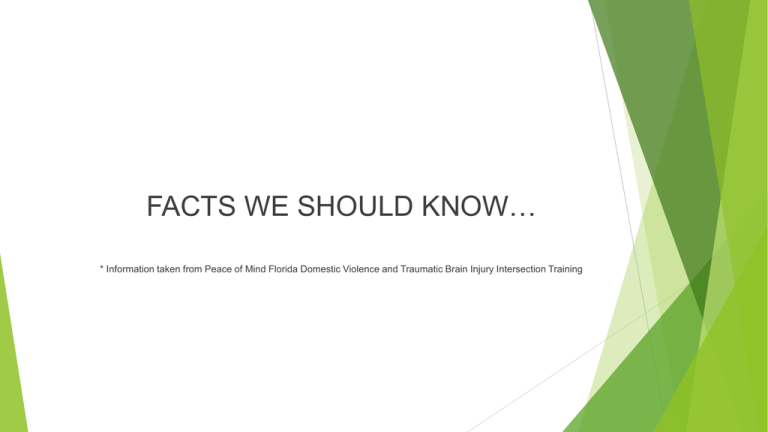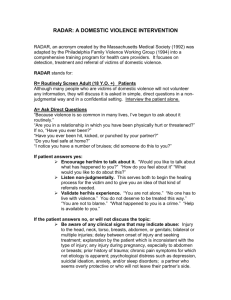
FACTS WE SHOULD KNOW…
* Information taken from Peace of Mind Florida Domestic Violence and Traumatic Brain Injury Intersection Training
*Know the facts
The next time you’re in a room with 6 people, think about this:
1 in 3 women and 1 in 4 men experience violence from their partners in their
lifetimes.
1 in 5 women are survivors of rape.
1 in 2 women and 1 in 5 men have experienced some form of sexual violence in their
lives.
1 in 4 women and 1 in 6 men were sexually abused before the age of 18.
- No More.org
DOMESTIC VIOLENCE
(DV)
DOMESTIC VIOLENCE..
Can happen to anyone of any race, age, sexual orientation, religion
and gender
A woman living with a disability is 85% more likely to be a victim of
domestic violence or sexual assault than a woman without a
disability
Women who have experienced domestic violence are 80 percent
more likely to have a stroke, 70 percent more likely to have heart
disease, 60 percent more likely to have asthma and 70 percent
more likely to drink heavily than women who have not experienced
intimate partner violence (Futures Without Violence-the Facts on Domestic Violence, Dating and
Sexual Violence Fact Sheet)
DOMESTIC VIOLENCE..
Women are more likely than men to be victimized by a current or former
intimate partner (National Crime Victimization Survey: Criminal Victimization, 2007. 2008 U.S. department of Justice, Bureau of
Justice Statistics)
DOMESTIC VIOLENCE IS…
A pattern of assaultive and coercive behaviors used by one person
in order to gain power and control of another
Abusive, disrespectful and hurtful behaviors that include physical,
sexual, emotional and economical abuse
A crime
Traumatic Brain Injury
(TBI)
Know the facts
There are more cases of brain injury than HIV, breast cancer and spinal cord
injuries combined
TBI can happen to anyone, anytime, anywhere
It does not discriminate
traumatic brain injury
An insult to the skull, brain or its covering, resulting from external
trauma, which produces a diminished altered state of
consciousness- which results in an impairment of cognitive abilities
or physical functioning or disturbance of behavioral or emotional
functioning.
An individual does not have to lose
consciousness to sustain a TBI
Intersection of TBI and DV
Across time……
In a 1998 study by Jackson and Phillips of 53 women living in a
domestic violence shelter, on average, the women experience five
(5) brain injuries in the prior year. Almost 30% reported 10 injuries
the prior year.
Research studies on the incidence of traumatic brain injury in
domestic violence cases have revealed: greater than 90% of all
injuries secondary to domestic violence occur to the head, neck or
face region. (Monohan and O'Leary, 1999).
Valera, in 2003, found that of the 99 battered women he studied,
75% sustained at least one partner-related brain injury and 50%
sustained multiple partner-related injuries.
Brain Injury Association of America…
A study attempted to survey 169 women who came to three
metropolitan emergency departments with injuries and health issues
directly related to domestic violence within a 7 to 9 month period.
The women were referred by the emergency room personnel to
sexual assault-domestic violence health staff who had been trained
in the use of the survey and given resource and referral information
about traumatic brain injuries.
Fifty-one women, or about 30% of the 169 women, agreed to or
were able to complete the survey at the time of the emergency room
visit. Forty-six women responded to all items on the survey.
Of the 46 women, a total of 71 separate cases of physical assault
were reported.
Thirty-eight percent of the women reported multiple assaults.
Overall, 35% of the survey participants were identified as possibly
having sustained a mild traumatic brain injury and were referred to
appropriate services.
Fourteen women, 30% of this group, reported that they experienced
a loss of consciousness on at least one occasion.
Fifteen percent of the women were hospitalized as a direct result of
injuries to the head.
Sixty-seven percent of the women, both who did and did not
experience a loss of consciousness, reported symptoms associated
with mild traumatic brain injury, such as headaches, dizziness,
difficulty concentrating, and memory loss.
Because batterers seldom assault their
partners only once, some victims
suffered repeated head injuries.
One study of women in three domestic violence shelters found that:
92% had been hit in the head by their partners more than once
83% had been both hit in the head and severely shaken
8% of them had been hit in the head over 20 times in the past year
The more times individuals had been hit in the head or shaken, the
more severe, and the more frequent, were their symptoms







